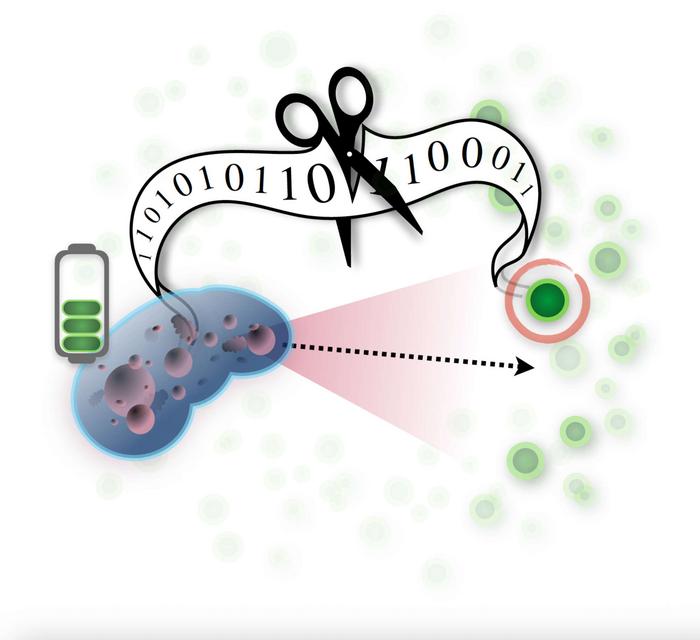Living systems—unlike non-living or inanimate objects—use information about their surrounding environment to survive. But not all information from the environment is meaningful or relevant for survival. The subset of information that is meaningful, and perhaps necessary for being alive, is called semantic information.

Credit: Illustration by Damian Sowinski
Living systems—unlike non-living or inanimate objects—use information about their surrounding environment to survive. But not all information from the environment is meaningful or relevant for survival. The subset of information that is meaningful, and perhaps necessary for being alive, is called semantic information.
In a new paper published in PRX Life, University of Rochester physicists and their coauthors have, for the first time, applied this theory of semantic information to a well-known model of living systems in biology and ecology: an organism or agent foraging for resources.
Using a mathematical model, the researchers simulated how a foraging agent moves in an environment and collects information about resources. The simulations revealed what the researchers have called a semantic threshold: the critical point where information matters for the agent’s survival. Above this threshold, removing some information doesn’t affect survival, but below it, every bit of information is crucial.
By quantifying the correlations or connections between an agent and its environment, the researchers are helping to reveal the role of information in that agent’s ability to maintain its own existence.
Correlations as connections
Imagine a bird in its forest. It knows where to find the food it has stored to nourish itself. Say you move that bird 100 feet to a different part of the forest. “By doing so, you’ve cut some of the bird’s correlations or connections with its environment, but there are still enough correlations that it doesn’t affect viability, or the ability of the bird to survive,” explains Damian Sowinski, the lead author of the paper and a postdoctoral associate in the Department of Physics and Astronomy at Rochester.
Now, move the bird 1,000 feet away—or, more drastically, 1,000 miles away.
“Eventually, the bird is not going to know anything about its environment—all of the connections are cut. The viability of the bird goes from not really being affected to all of a sudden starting to plummet,” says Sowinski.
By contrast, moving a non-living thing like a pebble 100 feet, 1,000 feet, or even 1,000 miles away doesn’t fundamentally change the connections between the environment and the pebble. That’s because the pebble isn’t harnessing any information—relevant or irrelevant—about its surroundings to maintain or reproduce itself.
“One of the most basic things that life does is consume resources while navigating in space,” says coauthor Gourab Ghoshal, a professor of physics at Rochester. “These new findings indicate that our way of thinking—the idea that there is relevant and irrelevant information for survival—shows promise when applied in a simple resource-foraging model. The big question now is, will our way of thinking still apply with increasingly complex models?”
From particles to people: How does agency emerge?
Agency means acting with a purpose or responding to the environment in a non-random way. That requires making meaningful connections with the environment—interacting, reacting, and then deliberately acting in ways that are self-maintaining and self-producing.
So, when and how does agency—in an individual, in a group, or in a system—emerge?
“That’s a deep philosophical question,” says coauthor Adam Frank, the Helen F. and Fred H. Gowen Professor in the Department of Physics and Astronomy. “The whole point of advances in science is to take questions that used to be the domain of philosophical speculation and find a way to talk about them quantitatively. This paper does that in a mathematically rigorous way.”
Such a broadly applicable mathematical definition of semantic information could offer new insights across the disciplines—from biology to cognitive science, philosophy to physics—into how living and non-living systems are related. That’s one reason why the John Templeton Foundation, a philanthropic organization that funds academic scholarship on critical topics crossing disciplinary, religious, and geographical boundaries, has supported the team’s research.
“By using this language of information theory, we’re creating a bridge between the mechanistic narratives in the physical sciences and the more informational or behavioral narratives used in the life sciences,” says Sowinski.
He, like his colleagues, is energized to continue the team’s line of inquiry into the fundamental mystery of life. As Sowinski puts it, “Our work is a promising first step to answering a bigger question: What in the world causes a lifeless rock full of pebbles to eventually be covered with purposeful entities that are interacting meaningfully with one another and their environment?”
Journal
PRX Life
DOI
10.1103/PRXLife.1.023003
Method of Research
Computational simulation/modeling
Subject of Research
Not applicable
Article Title
Semantic Information in a Model of Resource Gathering Agents
Article Publication Date
17-Oct-2023





